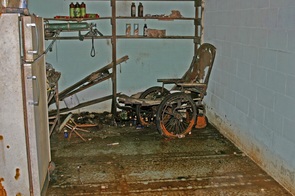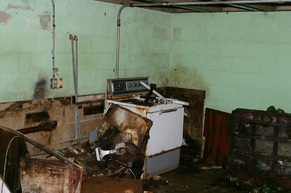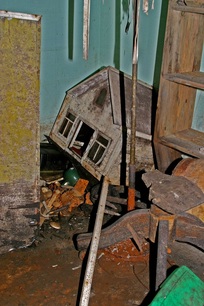|
A rare, first-hand account of a trip inside the city's hidden bomb shelter is the second part of this series. In 2006, with the promise of its location remaining a secret, writer Bill Sievert and photographer Rich Stayton were given permission to go underground for "Gimme Shelter", an article published in PULSE Magazine and now republished by Mount Dora Buzz. (For Part 1, click here )  A TRIP DOWN UNDER As Richard and I inch our way into the eerie darkness, having nothing but a flashlight and Richard’s flashbulbs to illuminate our path, I am overcome with the feeling that a nuclear holocaust truly has occurred and that we are witnesses to the end of civilization. Just past the steel trap door, the first relic we notice is an old-fashioned drug-store-style scale, which creates a momentary illusion that we are entering an amusement park funhouse (the dark and scary kind). We imagine that the scale was placed there not for member weigh-ins, but as a good-humored attempt to lighten the mood of panicky arriving occupants. Even the official house rules, a copy of which was provided to Pulse by the owner, are frightening. The regulations placed “authority for maintaining order” and “enforcement” of all rules in the hands of the Security Committee. “Distribution of all food and other supplies in storage will be in the hands of the Security Committee. … All firearms brought into the shelter will be tagged and locked up by the Security Committee ... The Security Committee will stop all disputes between parties, and those of a serious enough nature will be arbitrated by an arbitration committee composed of the chairmen of the Security, Medical and Maintenance Committees and two members of the Board of Directors. … The Security Committee may select from among the able bodied men additional persons to aid in protection of the shelter.”  The Medical Committee, led by Dr. Hall, was assigned responsibility for the “health and welfare of the shelter… All minor illnesses will be treated at a Sick Call at 8 a.m. each morning. Serious illnesses will be treated at any time.” Smoking, not regarded the health hazard it is known to be today, was permitted, but only in the 40-foot by 20-foot great hall. Other rules instituted curfews: “Children under the age of 9 years must be in their units by 7:30. All persons must be in their units by 11 p.m. and quiet time will be observed until 7 a.m. There will be a quiet hour from 2 p.m. until 4 p.m. daily.” It was left unstated how the Security Committee intended to punish infractions of policies when, as time wore on, children misbehaved and adult tempers flared. An “Agricultural Committee” was to “make assignments of jobs to the members for the purpose of growing crops to feed the members after leaving the shelter.” The committee had a lot to work with. On our tour, we are amazed at the stockpile in the large closet known as the “seed room.” The metal shelving units on which the cans once stood have crumbled into rusty red dust, but hundreds of containers of seeds, most of them still sealed and secure from the prowling roaches, have spilled into the hallway.  The seed room is located at the northern end of one of twin corridors that attach to the central hall on both sides, forming a layout shaped like the letter H. The hall, which served as the communal recreation and meeting room, is situated just beyond a thick wooden door from the entrance area (the wood door served as a secondary barrier to access, just in case someone successfully circumvented the steel trap). The wood door also kept residents away from the electrical-generator room (the shelter had a sophisticated system of air-conditioning and air filtration) and a decontamination room. In one corner of the common hall is the community kitchen, its four-burner stove and sink still present but the latter crumbling badly. There’s no way, we think, that such a tiny facility, seemingly designed for a cottage or motel room, could possibly handle food preparation for up to 100 people. The rules said nothing about cooking or dining shifts, so we have no idea how the residents planned to share the space.  Some people, however, must have been planning to dress for dinner. In one of the sleeping units in the west wing of the H, we are startled by the form of a woman – but, resisting the urge to run, we discover that it is merely a ragged, patterned party gown draped over an old wire hanger. At one time, the dress had been beautiful and probably quite expensive; now it was the last remaining garment on what had been a rod full of clothing. Perhaps it belonged to the wife of the coop member who, according to the current owner, left behind an entire rack of business suits. Some of these people clearly intended to maintain a semblance of formality. Most of the shelter’s contents were cleared out before the cooperative dissolved, and other items were removed by the property’s current owner. Still, what remains constitutes a memorable peek into what it might have been like to inhabit The Catacombs. I won’t easily forget a child’s playroom or, perhaps it was intended as a classroom. In one corner, a handcrafted dollhouse leans atilt against a rickety plank bookcase. On a shelf is a short stack of decayed volumes – no titles could be deciphered – but from the index thumb markers, the top book appears to be a dictionary. Nearby, pieces of an abandoned jigsaw puzzle – its once bright imagery reduced to plain cardboard – have melted into a tabletop.  Searching gingerly through the relics of The Catacombs is not unlike sorting through the pieces to a complicated jigsaw puzzle – one bit of history fits here, another there. Richard and I stay much longer than we had planned, despite my expressed fear that the owner (who had left us alone) might become annoyed at our dawdling and seal us inside. Even in such a large space, it is impossible to escape the feeling of claustrophobic confinement. As we finally begin climbing the stairs and notice rays of sunlight pouring in from above, I can’t help but wonder whether something should be done to preserve what is left of this one-of-a-kind monument to a dark period of history, and to restore what has been lost. Perhaps a state or federal agency should attempt to purchase the property, turn the lights and air-conditioning back on, and allow the public inside. Our planet still possesses the capability to destroy itself with nuclear weaponry many times over, but if enough people had access, The Catacombs could serve as a strong reminder why we never want to come so close to the atomic precipice again. If you missed the Part 1, click here. For part 3, click here. "Gimme Shelter" was written by Bill Sievert, owner of The Wow Factory in downtown Mount Dora, and Richard Stayton was the photographer. Bill was one of the founding partners of PULSE, along with Carole Warshaw, Jane Trimble and Aaron Marable. Permission was generously granted to Mount Dora Buzz to reprint the story, so more people could learn of this piece of local history. |
Archives
February 2023
Categories |
 RSS Feed
RSS Feed